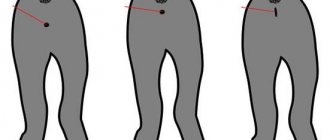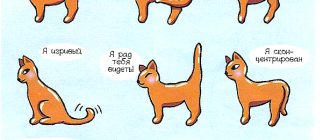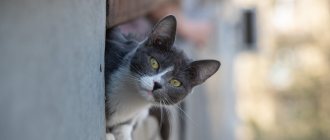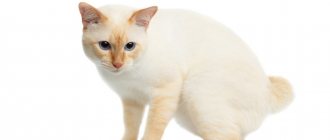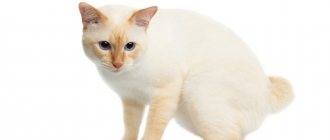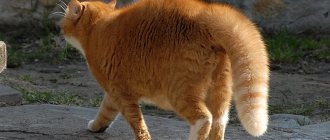The vast majority of people believe that our smaller brothers, namely cats, do not know how to express their feelings and moods. But this is not true at all. Cats' body language is very simple. The emotions of cats are very understandable and accessible to everyone.
To do this, you just have to watch carefully, and you will learn to distinguish, how to understand the cat's language. It is expressed primarily in the way the cat shakes its tail. But let's take a closer look at how and why cats shake their tail.
How cats show their mood
A cat's tail consists of many vertebrae and performs a large number of functions. The main role is balancing during movement and hunting. But a cat's tail is also an expression of her behavior and character. This means that if the owner is attentive and loving, then it will be easy for him to determine the cat’s mood by the tail. It is when and how a cat shakes its tail that you can understand what mood it is in.
A cat's tail twitches in different ways - both vertically and horizontally. To figure out how to understand a cat by its tail, you need to take into account many factors. These may include:
- people unfamiliar and incomprehensible to them. For older cats, this can be a stressful environment. And if this is a cat with kittens, then the trembling tail will immediately let you understand displeasure and fear for its offspring;
- general situation in the breeder’s family. If you constantly scream and at the same time can periodically hit the kitten, you should be prepared for the fact that the cat arches its back and its tail is fluffed or tucked. But when you love and cherish your pet, then his tail will almost always be a pipe, and the threat of an arched back and hissing sounds will bypass you;
- If an animal beats its tail, meows, shakes, its pupils are dilated and it tucks or arches its tail, then the pet is letting you know that it is experiencing fear. In such a situation, it is better to remove the object that provoked panic;
- An unfamiliar environment or moving can also cause displeasure in the pet, which will be expressed in the fact that the cat jerks its fifth limb. Let her know that you are looking out for her and want the best for her.
INTERESTING TO KNOW: How to properly care for a Thai cat
Cats can perfectly understand what you are communicating with them about. As the kitten grows up, it learns to understand its owner, and you learn how to determine its mood and how to understand your pet’s language.
Fingering with paws
Cat massage - no matter how it is called in different languages! And “kneading dough”, and “kneading puree”, and “playing the piano”, and - if the cat’s claws are not trimmed - even “free acupuncture”. But no matter what fancy names they come up with for this phenomenon, its essence remains unchanged. These are the movements that kittens make while suckling their mother, kneading her belly for a better flow of milk.
Considering the pleasure that the process of eating their first food brings to babies, it is not difficult to guess that in adult life they make such movements only in moments of the highest contentment associated with a feeling of complete comfort and security.
How cats communicate using their tails
It is not always possible to understand from the face how to determine the mood of the animal and figure out what the cat wants. And it is the cat’s tail that will tell you about all the thoughts and emotions of the pet. Let's look at specific examples of why and how a cat twitches its tail:
- The four-legged pet smoothly swings its tail horizontally in different directions. Cat experts indicate this gesture as the fact that she cannot immediately make a choice between her desires. When the decision is made, the animal will calm down and stop twitching;
- if a cat lifts its tail and puts it vertically, it tells you that the pet’s thoughts are very interested in something;
- a slight twitch indicates strong affection and love for you;
- if the cat’s fifth limb is down, it means that she is bored;
- the tail is up, but the back is arched and the ears are pressed back - the cat cannot decide whether to attack or defend. He is very scared;
- the tail is in a curved arc position and the cat arches its back - it senses danger and is ready to defend itself. In this state, do not hit her and try to calm her down;
- a tail raised up (vertically) indicates that the animal is in a great mood and is ready for games and communication;
- a loosely drooping tail tells that the pet is in a calm mood, but is not inclined to communicate;
- a measured and rather strong horizontal waving of the tail indicates dissatisfaction and irritation;
- a wary animal's tail is lowered and ruffled;
- only the tip of the tail moves slightly - at the moment the pet is in an excellent mood and is happy with everything that is happening around him;
- the cat’s tail trembles and moves horizontally in different directions faster and faster - the hunt is in full swing and an attack on the prey will occur in the coming seconds;
- a vertically extended, quivering tail denotes a playful mood. It’s worth considering here that if the movements become faster and sharper, the cat beats its tail and may start meowing - the animal is getting too excited and it’s time to stop it. This is especially true when playing with small children - the danger of scratches and bites from a cat is too great;
- a tail wrapped in a ring around the body speaks of an excellent mood and trust in the surrounding world;
- the tail is raised halfway - the pet is confused and cannot determine its attitude towards a person or animal - to understand whether it is a friend or an enemy;
- fluffy tail and fur along the spine - the cat is furious;
- a vertically raised tail may mean that the cat is marking territory;
- sharp waving or tapping indicates stress and possibly pain;
- biting the tail signals the presence of parasites;
- in cold weather, cats wrap their tail in a ring around themselves, thereby reducing heat transfer;
- a vertically raised tail with a relaxed tip indicates joyful excitement;
- sits or lies with the fifth limb calmly extended - the cat is resting;
- in a sitting position, with paws tucked and tail wrapped - the animal is relaxed, but waiting for some action;
- a slight twitching of the whole body along with the tail means happiness and calmness of the pet. You can observe this when stroking it, scratching its ears or back. Will also be expressed in loud purring and squinting of the eyes;
- a leisurely and rhythmic twitching of the tail vertically indicates interest in something. The cat is relaxed, does not feel danger and is concentrated on the object of its attention. It is also expressed in the fact that the animal walks around the object of its interest and sniffs it;
- the desire to attack can be expressed in walking the fifth limb from side to side. If this occurs when playing with inanimate objects, then there is no need to worry. As soon as the cat gets tired of this activity, it will move away from it and forget about it quite quickly. At least until the next surge in gaming activity.
INTERESTING TO KNOW: How to properly wash a cat?
Cats move their fifth limb almost constantly. There are many explanations for this fact. When communicating, you just need to pay attention to your pet’s mood. When there is mutual understanding between the owner and the pet, when they can understand and feel each other, then there will be practically no problems in communication.
Just listen to what your cat is telling you. Indeed, contrary to popular belief, tail twitching can also mean great love and devotion towards you.
Purring and other sounds
This is the most understandable signal for such a talkative creature as a person. Everyone knows that a purring cat is a happy cat, although in fairness it should be said that she makes vibrating sounds not only when she is happy. For example, older cats may purr when approaching younger ones to show that they are friendly and do not claim power.
Animals can purr to calm themselves down in a stressful situation. But, basically, it is still a sure sign of contentment, just like meowing in certain situations. For example, when a cat enters a room and, seeing you, utters a melodious “meow”, then most often it wants to say: “I’m happy to see you! And don’t I deserve attention and affection for this?”
Health of tailed animals
The cat's tail must be protected from injury. It contains a lot of nerve endings that are responsible for regulating the intestines, hind legs, urinary system and kidneys. If a cat is pulled strongly and sharply by the tail, this can lead to temporary or long-term loss of capacity. She may stop walking, experience urinary incontinence, not to mention the pain that the poor animal will experience.
It happens that when landing incorrectly, falling, in a fight, being crushed by a door, or other external influence, the cat runs the risk of getting its tail dislocated. A sign of a dislocation is its unnatural position. If you notice this, take the animal to the doctor immediately. X-rays, correct sequential manipulations by a veterinarian, a tight bandage, perhaps even a splint will help your pet regain its tail health.
The condition of the hair on the tail is of great importance because it reflects the overall health of the four-legged friend. If the hair on the tail falls out, it could be dermatitis or allergies.
It is not uncommon for a cat to lose hair on its tail due to stress. This problem needs to be treated by understanding its origins. If it is a bacterial infection or fungal infection, they must be treated strictly as prescribed.
For example, the tail of sphinxes is in particular danger - it is the first to suffer from the animal’s skin problems, of which this breed has many.
If a cat's tail hair is thinning or falling out in patches, the cause can be determined by a veterinarian through a visual examination and blood tests. Do not rush into a consultation and do not treat yourself, as you may aggravate the symptoms of the emerging problem.
A cat's tail is a unique part of the body. Many centuries ago, a person also had a “tail”, but now we only have an atavism – the tailbone. The memory of ancestors carries deep in the subconscious an understanding of the behavior of your furry pet based on its tail.
Features of the structure of a cat's tail
In most cats, the tail makes up approximately 10% of the total number of vertebrae in the spine. A more specific figure is 19–23 vertebrae. The unique maneuverability of the tail is provided by the musculoskeletal structure, which also includes ligaments and tendons. In an adult, the tail is on average:
- in a cat - 25 cm in length;
- for a cat - 28 cm.
The tail is an extension of the spine
The spine of felines has a “logical” conclusion - the tail. This part of the animal’s body has a certain special status, since the sacral region has fused vertebrae, representing a single bone, and the tail originates from there. Its external characteristics are somewhat reminiscent of a whip.
A cat's tail makes up the caudal section of its spine.
The cat's tail is conventionally divided into three fragments:
- root;
- stem;
- tip.
The vertebrae are wider in diameter at the base and narrow towards the tip. They are shorter in length. The first 5–8 vertebrae resemble an arch. The last vertebrae do not have a spinal canal. The end of the tail is crowned by a vertebra of small length and diameter. It is distinguished by asymmetry or sharpness. It may also be rudimentary (underdeveloped).
Between the vertebrae there are intervertebral discs, they are very plastic, so the cat's tail is very mobile.
The tail is very strong thanks to the ligaments. High mobility of the tail is ensured by three long tail muscles and a large number of short ones.
The cat's tail is equipped with muscles that ensure its high mobility.
Video: why you shouldn’t pull a cat’s tail
Cat tail length
Cats - owners of long tails - have different lengths of this part of the body. The measurement is taken from the extreme point of the sacrum to the extreme point of the last vertebra. The length ranges from 20–28 cm to 40 cm, which depends not only on the individual characteristics of the animal, but also on its breed. For example, Persian cats have a shorter average tail length than Orientals, while Maine Coons have a slightly longer tail.
Maine Coon is a breed of long-tailed cat
About tailless cats
There are cat breeds that have a very short tail, and there are those that don’t have one at all. There are only two breeds of completely tailless cats: Manx and Cymric. These breeds are not allowed to breed other cats. The reason for the lack of a tail was genetics.
Cymrik - a breed of tailless cats
In addition to tailed and tailless cats, there are cat breeds that have short tails. These include the bobtail breed. The tails of these animals are limited to 5–7 vertebrae, have strong pubescence, resembling a pompom in appearance.
Japanese Bobtails have a very short tail that looks like a pom-pom.
Cat tail thickness
The tail is divided into two types based on the thickness of the vertebral stem: thin and thick. The assessment is based on the massiveness of the animal and depends on the strength of the bones. The average value of this parameter can rarely be found. Often when describing the tail, the shape is indicated instead of the thickness, for example:
- tail, thick at the base;
- tail tapered to the tip;
- thin tail.
Photo gallery: cats of different breeds and their tails
Other anatomical features of tails, genetic anomalies
Some cats have abnormal tail shapes. They can be represented:
- crease. It represents the elevation of one vertebra above another. It turns out to be a kind of step-up effect. These vertebrae may be the same in length, or they may be different. The edges are necessarily rounded;
- kink. Step down effect;
- bending Elevation of one or more vertebrae above an imaginary straight line. Often vertebrae with this anomaly have a wedge shape;
- knot formation. Several vertebrae fuse into one.
Physical problems
Veterinarians focus on the health status of the pet if its behavior is a symptom of disease. The reason for chasing your own tail can be pain, itching, burning caused by:
- parasitic diseases – worms, fleas, ticks;
- inflammation of the paraanal glands;
- anal herbs;
- constipation;
- skin diseases;
- allergies to food;
- tail injuries - fracture, bites of other animals, compression, torn ligaments;
- mental disorders, for example, the consequences of brain injuries and infections.
It is necessary to pay attention to such behavior in a timely manner. Also watch the video why a cat chases its tail:
Also watch the video why a cat chases its tail:
